Letters from Lodi
An insightful and objective look at viticulture and winemaking from the Lodi
Appellation and the growers and vintners behind these crafts. Told from the
perspective of multi-award winning wine journalist, Randy Caparoso.
A full telling of the Plains Miwok, the "first people of the Mokelumne"

The Mokelumne River region's natural riparian environment — grassland and deep-rooted valley oaks, teeming with acorns — is preserved today in Lodi's Jessie's Grove estate.
To know the people who originally lived in the watershed area now recognized as the Lodi Viticultural Area is to know why wine grapes grow so well here. Almost effortlessly, Lodi has become easily the most widely planted wine region in the United States, growing twice as much acreage of vines than Sonoma County and the vaunted Napa Valley regions combined (or you can say, more than the entire states of Oregon and Washington combined, plus at least another 25%).
This is a land blessed with intrinsic ease of sustainability (in the original sense of the word) between the natural environment, grapes, and people.
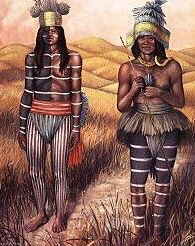
Depiction of feathered and tattooed Miwok in Harry Knill's book, Great Indians of California.
Insofar as people, it is the Plains Miwok who roamed the lush, fertile riparian zone between the Cosumnes and Calaveras rivers — with the Mokelumne River in between, rushing down from the Sierra Nevada and into the Sacramento-San Joaquin River Delta — for at least a thousand years before meeting the first explorers and settlers of European descent.
Other than the Plains Miwok, there are 10 more indigenous tribes identified by the U.S. Bureau of Indian Affairs as Miwok, or speakers of the Moquelumnun language. The Miwok tribes originally ranged from California's North Coast to present-day Lake and Contra Costa counties, extending all the way up into the lower foothills of the Sierra Nevada.

1655 engraving imagining the Coast Miwoks' meeting with Sir Francis Drake in 1579.
According to Spartacus Educational, the first encounter between Miwoks and Europeans took place on June 17, 1579, when Sir Francis Drake landed near present-day Point Reyes, dropping anchor in what is now called Drakes Bay (called Tamál-Húye by the Coast Miwok). In a telling later recorded, in 1582, John Drake described meeting the Coast Miwok people who populated this coastal area:
During that time (June 1579) many Indians came there and when they saw the Englishmen they wept and scratched their faces with their nails until they drew blood, as though this was an act of homage or adoration. By signs, Captain Francis Drake told them not to do that, for the Englishmen were not God. These people were peaceful and did no harm to the English, but gave them no food. They are of the color of the Indians here (Peru) and are comely. They carry bows and arrows and go naked. The climate is temperate, more cold than hot. To all appearances, it is a very good country.
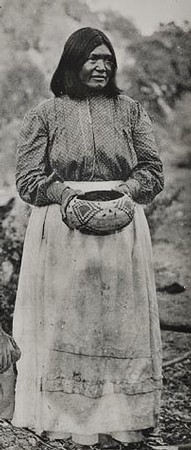
1905 photograph of Miwok woman.
Father Francis Fletcher, the chaplain on the Drake expedition, made a few observations of the Miwoks' social behavior, writing in The World Encompassed by Sir Francis Drake (1628):
Their men, for the most part, go naked, the women take a kind of bulrushes, and keeping it after the manner of hemp, make themselves thereof a loose garment, which being knitted about their middles, hangs down about their hips, and so affords to them a covering of that, which nature teaches should be hidden: about their shoulders, they also wear also the skin of a deer, with the hair upon it. They are very obedient to their husbands and exceeding ready in all services.
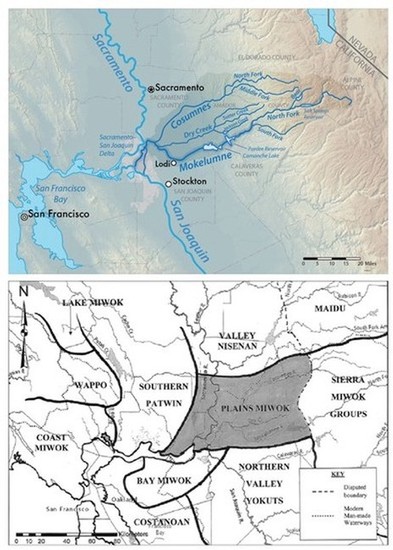
Modern-day Mokelumne River watershed markers (above) coincide with the Plains Miwok territory.
By 1848, when the first settlers of European descent began to claim properties further inland, in the watershed area in and around the Mokelumne River, the Plains Miwok were already displaced from their home of over a thousand years. Most had succumbed to a succession of epidemics or were relocated or enslaved by Spanish missionaries and soldiers, between 1811 and the early 1830s. Between the late 1820s and 1840s, the Plains Miwok suffered even more violence at the hands of surging numbers of Mexican ranchers.
After California was ratified as a state in 1850, treaties setting aside lands for Miwok tribes were signed, but as well as told by history, these treaties were never honored. Instead, surviving Miwok were forced onto reservations. In 1906, 54 Native American rancherias — federal lands designated for Aboriginal settlement — were established in California.
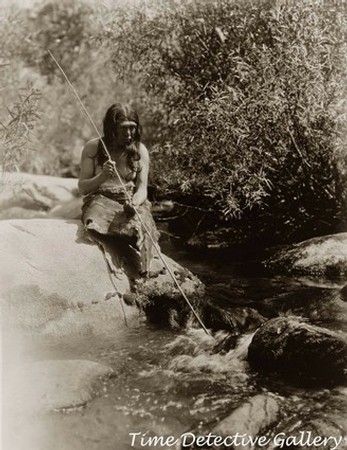
1924 photograph of Miwok fishing.
Today, little remains of people with varying degrees of Miwok blood live in either these rancherias or intertribal reservations such as the Round Valley Reservation in Mendocino County or are spread out in towns throughout Northern California. While their numbers are small, descendants of the Lodi area's Plains Miwok tribe can still be found — albeit everywhere, or so it seems, other than their original home between the Delta and the Sierra Nevada.
Christi Kennedy's narrative in Lodi, A Vintage Valley Town
You can find a good amount of information on the life of the Plains Miwok online. There is probably no better summary, however than what was written in the book called Lodi, A Vintage Valley Town, authored by Christi Kennedy, and published in 1994 by the Lodi District Chamber of Commerce. Kennedy is also known locally as Christi Kennedy Weybret, the wife of Marty Weybret, former publisher (up until 2015) of Lodi News-Sentinel.

With permission from Ms. Kennedy as well as Pat Patrick, CEO/president of the Lodi District Chamber of Commerce, we think it best to quote directly from Kennedy's thoroughly rendered book, which gives as vivid an illustration of the Plains Miwok way of life and homeland as you can find.
The Mokelumne River's perennial bounty
Kennedy begins her chapter on the Plains Miwok with an imagined vignette based on her research:
The small Indian boy sat motionless, crouching among the cattails and tules [a.k.a. bulrush] on the banks of the wide river. He looked intently into the clear depths of the river as he had done for days. The spring sky was filled with ducks, geese, and cranes flying overhead. But the boy only watched them in the reflection of the water.
Then he saw the flash of silver in the water — the first salmon of the year rushing upstream to spawn. The boy's legs hurt from crouching for so long, so he ran excitedly back to the village called Muk-kel.
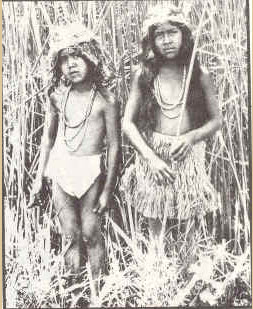
Late 1800s photo of Miwok children.
A few women were weaving baskets to carry acorns [from the indigenous valley oak trees growing throughout the river region] they gather for food. A man was preparing the ligaments from a deer's hind leg to use in a bow while another man nearby used a stone tool to finish carving a harpoon for spearing salmon. The village chief came out of the sweat house as the young boy breathlessly ran up to him.
When he heard the news, the chief called the people in the village together to announce the event that had become their only meaningful measure of time, the coming of the salmon. The time to gather their supply of fish to come.

In late March, the Mokelumne River east of the City of Lodi, a far more sedate and considerably less bountiful waterway than it was during the last days of the Plains Miwok in the late 1700s.
The fruitful valley before the arrival of Europeans
Life along the river in the place that would someday be called Lodi was a productive and largely peaceful existence. The Central Valley and the San Joaquin-Sacramento Delta region teemed with wildlife and lush vegetation. In its pristine state, the valley's Riverlands were covered by a dense canopy of towering valley oak trees with branches reaching out toward the ground covered with a lush carpet of grass and wildflowers. The branches of the oaks and willows near the riverbed were draped with vines of wild grapes and blackberries. The rivers were filled with salmon, sturgeon, trout, and perch, and the riverbanks were home to many animals including beavers, otters, raccoons, deer, rabbits, and birds of all kinds. Grizzly bears rumbled through the foothills, and vast herds of elk and antelope roamed the valley grasslands.
The Indians flourished in this central region of California with its bountiful gifts of food and water. Archeological studies date human activity in California as far back as 2,400 B.C. [our note: more recent excavations give evidence of human remains in California dating back 130,000 years]. The first known people of Central California were believed to speak Hokan. They were later replaced by speakers of the Penutian language. This language group then became divided into many separate tribes and language groups.

Miwok teepee is constructed of wood bark.
Gene Larkin, a Lodi expert on California Indians, reports that when white men first appeared, there were seven languages spoken in 105 different dialects in California, and about 60 percent of the total population in the Central Valley because of its plentiful food supply. The fruitful valley supported the densest population of Indians in the nation, an estimated average of two people per square mile.
The Plains Miwok lived in the area of present-day Lodi, inhabiting the lower reaches of the Mokelumne and Cosumnes rivers, south to the Calaveras River, and occupying both the banks of the Sacramento River from the present sites of Rio Vista to Freeport. Three separate groups of Plains Miwok — Mokelkos, Lalas, and Machacos — lived in the area.
The Miwok were a hunting and food-gathering people, which meant they followed their food supply and more agreeable weather. In the warm months, they moved up to the grassy foothill regions, and in the cold months, they moved downriver to the valley. Their movements followed the supply of acorns, their most important food source, but they also moved to escape fleas. As Larkin enjoys telling to ready audiences, the Miwok kept dogs for warmth while they slept and to eat if the food supply gave out. They moved whenever they could no longer stand the resulting fleas. Although they migrated frequently, the Miwok never ventured far from their food supply. Typically, they lived their entire lives within a region of 20 to 30 miles.

1928 photo of a Miwok ceremonial roundhouse with an imagining of communal activity inside.
The village of Muk-kel, which is sometimes spelled "Mokel," is a Plains Miwok settlement along the river. Although its location is not definite, it is believed to have been located a few miles west of present-day Lockeford.
Village life was occupied principally by the gathering of food and related activities. Women gathered and prepared acorns, dug roots, picked berries and wild grapes, made finely woven baskets, and worked animal hides into leather for clothing. Men hunted and fished; they built tools, animal traps, and fishnets; and they maintained the sweat house.
The clothing of the Miwok was minimal. Women were short-covering attached to their waists made of tule, plant fiber, buckskin, or the shredded inner bark of trees. The men went naked or wore apron-like coverings made of buckskin. In cold weather, men and women would wear simple moccasins, animal skins, and blankets woven from feathers or rabbit fur strips.

Valley oak acorns are the staple of the Plains Miwok diet.
The gathering and preparation of acorns, their principal food source supplying 60 to 80 percent of their diet, required an intense effort by about a third of the village population. Women gathered the acorns and stored them in caches or granaries, which were structures of loosely woven willow sticks and grass elevated a foot or two above ground. These granaries allowed air circulation to prevent mold.
To prepare the acorns, women pounded them in mortars of stone or oak. Because their tannin content made acorns taste harsh, the women performed a long process to cook out the bitterness. A woman would put the acorn powder, water, and hot stones in a watertight basket. When the acorn mush boiled, she would move a stick to one side and repeat the process. When she had moved 10 sticks, the cooking was done and the bitterness was gone. The women carried these special sticks with them all their lives and were often buried with them. Once the acorn flour was prepared, it was used in preparing a variety of foods. A favorite meal was small cakes made from flour mixed with berries (Larkin).
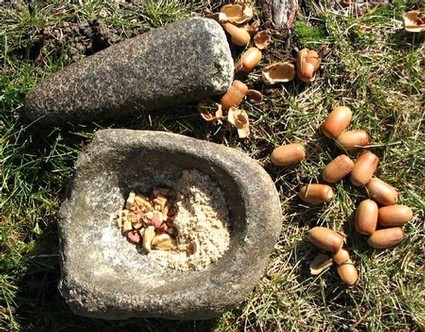
Miwok stone mortar.
Living off a fertile Riverland
Hunting, trapping, and fishing occupied the men's time. The Miwok ate just about anything except animals that smelled, preyed on man, or were sacred to them. Fishing for large prey, like salmon or sturgeon, was accomplished with large spears, their points fashioned from tule, elk, antelope, or deer antlers. Smaller fish were caught with traps woven with willow and grapevines.
The men killed rabbits by driving them into nets and clubbing them. Nets were also used to snare unsuspecting ducks, geese, and other waterfowl quietly feeding at the water's edge. Men hunted ducks by immersing themselves in the cold water with only a reed to breathe through and a skinned duck's body on their heads as a decoy. Adorned with this disguise, a hunter would move silently underwater, ease himself up to a duck, grab its feet, pull it underwater, and break its neck, leaving barely a ripple of water.

Miwok sweat lodge (Yosemite Valley).
The Miwok's method of hunting deer is perhaps the best example of their cunning techniques. In preparation, the men sat inside the village sweat house, a structure built into the ground around a fire pit. The sweat-house was enclosed by a roof covered with branches, grass, and earth with a small hole to vent the smoke. As the fire forced up the temperature in the sweat-house, the men scraped the seat off their skin with the curved rib bones of deer. Then they ran outside, jumped into the river, and returned to the sweat house to rub herbs over their bodies to remove, or disguise, the human scent. Finally, the men painted their arms and chest white to resemble the underside of deer and then disguised themselves with deer heads and hides draped over their backs. Prepared in this manner, the hunters were able to get close enough to kill their prey with bows and arrows.
It is interesting to note that the white man in later years scorned the native people despite their resourceful methods of surviving off the land. A particularly ungracious California writer in 1858 wrote of them, "Hunting (is) too active an employment to square with their ideas of ease and comfort, and consequently is not very vigorously followed."
Continued in our next blog post: The supplanting of Plains Miwoks' sustainable life by European, Mexican, and American cultures

Colorized version of 1700s illustration of Miwok in full body paint.